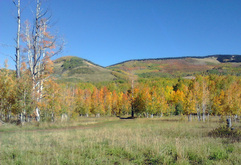 An aspen grove where many of our aspen sapling handles were harvested. An aspen grove where many of our aspen sapling handles were harvested. One of the most common questions I’m asked by customers is “How long does it take you to make a broom?” This is often a difficult question to answer. It is easy enough to determine how long it takes me to take a prepared broom handle and to tie on the broomcorn to make a finished broom, but the most time-consuming and difficult part of the process is finding suitable handle material and preparing it in a way that will allow it to lend a functional and aesthetic charm to the each broom. The first necessary part of obtaining a broom handle is finding a source of sustainably harvested saplings or tree branches. Saplings are ideal because they grow straighter, however some tree branches, such as apple wood water shoots, can also grow straight and long enough to be used as a broom handle. The majority of our broom handles come from aspen saplings sustainably harvested with a commercial permit on a local National Forest. These are often the most time-intensive broom handles, since we must drive high in the mountains to large aspen stands and hunt around for the perfectly sized and shaped saplings. The rest of our broom handles are a conglomerate of harvesting invasive Russian olive saplings, pruning fruit trees, or “rescuing” the wood from neighbors’ burn piles.  Aspen saplings with the ends waxed and slowly drying to prevent checking. Aspen saplings with the ends waxed and slowly drying to prevent checking. The next step is allowing the wood to dry slowly so the broom handles don’t exhibit excessive checking (cracking), so after harvesting, we paint the ends with wax and store them for a few months to allow them to dry. After obtaining and drying the wood for the handles, we have to decide whether each handle would look better with the bark still on or whether we should remove it. The majority of fruit tree woods have interesting color and texture in their bark, so we generally leave that on, while aspen provides interesting coloration and texture both with and without the bark, so we peel some to provide a mixture of options for our brooms. The handles are then coated with a clear-coat, both to preserve the bark on the broom handle and to keep the broom handle clean. Each broom handle requires hours of attention and adds unique charm to the finished product!
4 Comments
I.H.
1/14/2020 05:29:24 pm
Can you tell me how a mass produced natural (as in not painted, polished, but obviously sanded and perfectly straight...cheap kind used for brooms in central America, and elsewhere) can as I have seen turn from emergency fence post stick into a tree? I have searched the internet and can not find an answer. Do you have one?
Reply
1/26/2021 02:21:04 pm
It was interesting to learn that apple wood water shoots is a good material for making a broom. I need a new broom because my old one broke. I will look for a broom to purchase that is made of good materials.
Reply
Leave a Reply. |
Marybeth GarmoeCraftsperson Archives
August 2019
Categories |


 RSS Feed
RSS Feed

